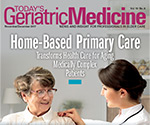 |
Each year, transient ischemic attacks (TIAs) occur in more than 200,000 Americans. These mini-strokes, caused by blood clots impeding blood flow to the brain, can be important harbingers of impending ischemic stroke. Immediate evaluation and intervention following TIAs can reduce the risk of stroke by nearly 80%.
In addition to reading our e-newsletter, be sure to visit Today’s Geriatric Medicine’s website at www.TodaysGeriatricMedicine.com, where you’ll find news and information that’s relevant and reliable. We welcome your feedback at TGMeditor@gvpub.com. Follow Today’s Geriatric Medicine on Facebook and Twitter, too.
— Barbara Worthington, editor |
 |
 |
Mini-Strokes Can Be an Ominous Prelude to Catastrophic Strokes
Each year, more than 200,000 Americans experience mini-strokes known as transient ischemic attacks (TIAs).
Patients suffer strokelike symptoms such as paralysis on one side or difficulty speaking. While symptoms typically disappear in less than a few minutes and there's no brain damage, TIAs often are followed by severe strokes.
TIAs are an “ominous prelude to an impending cerebrovascular catastrophe, but also the opportunity to prevent a disabling event,” Loyola Medicine neurologists Camilo R. Gomez, MD; Michael J. Schneck, MD; and José Biller, MD, report in the journal F1000Research. However, the Illinois neurologists add that rapid evaluation and treatment can reduce the risk of stroke by about 80% during the dangerous first week following a TIA.
Most strokes are ischemic, meaning they are caused by blood clots that block blood flow to a part of the brain. TIAs also are caused by blood clots, but the clots quickly dissolve or are dislodged. However, there's a 5% to 10% risk of suffering a stroke during the 30 days following a TIA, and 15% to 20% of ischemic stroke patients report having experienced an earlier TIA.
Full story » |
 |
 |
Home-Based Primary Care Transforms Health Care
for Aging Medically Complex Patients
Expanding the availability of home-based primary care services to some of the neediest elderly homebound patients increases quality of care while significantly reducing costs. A nationwide network has launched a program designed to educate providers interested in home-based primary care. Read more »
Managing the Behavioral Symptoms of Alzheimer's Disease
Factors such as pain, medication interactions, and changes in circumstances can prompt undesirable behaviors in Alzheimer's disease patients. It's important to determine the source of the problem in order to identify an appropriate intervention. Read more »
Addictions and Neurocognitive Disorders: What Counsel Can Primary Care Providers Offer?
Addictive behaviors in older adults with neurocognitive disorders require specialized interventions as well as education for family members and caregivers. Read more » |
 |
|
|
 |
Patients in Chronic Pain Face Stigma, Suspicion
An article in the Indianapolis Star notes that efforts to control and curtail the use of opioid drugs have stigmatized many who take legally prescribed medications and create significant problems for patients with chronic pain.
Hospice Agencies Come Under Scrutiny
Complaints of unresponsive personnel, inadequate pain relief, and questionable oversight suggest hospice care fails to meet patients’ and caregivers’ expectations in some cases, according to an article posted at Kaiser Health News online.
Studies Strengthen Evidence
of Diet-Cancer Link
With 13 separate cancers linked to overweight or obesity, there’s no denying the diet-cancer connection, according to an article in the Los Angeles Times.
Frailty Increasingly a Factor
in Surgical Procedures
According to an article in The New York Times, surgery performed on a physically frail older adult carries a significantly increased risk of poor outcomes. |
 |
|
